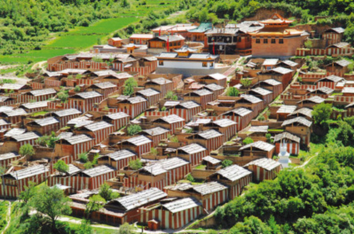Baigusi Temple Protection Forest, China

Description
In Duo’er town in China’s Diebu county, 260 monks have been conserving biodiversity since 1982. By preserving the 5.3km2 Protection Forest of Baigusi Temple, they help to conserve a wealth of species. The temperate coniferous forest includes an area of 1.5km2 where no natural resource use is permitted. Elsewhere in the forest, resources are used by the monks for subsistence and cultural purposes. The community aims to protect the forest’s spiritual and sacred value, as well as maintain its ecological integrity.
History and Activities
The Baigusi Temple was established in 1839 under Danren Baoqin. The Baigusi Temple is associated with three local villages called Baigu, Xirang and Ranzi in Gansu province, and half of Daheng village in Sichuan province. The temple was closed in 1958, but reopened in 1981. It was shortly after this, in 1982, that the Protection Forest was established. The monks obtained shared management rights over the surrounding forests, securing a degree of decision-making power.
Conservation
The natural environment surrounding the temple is a mosaic of coniferous forest, needle-leaved and broad-leaved mixed forest, bushes and dense grasses. The dominant tree species are firs, spruce, big-branch spruce, red birch and oriental white oak. By protecting the forest’s habitats, the monks help to ensure the survival of more than ten endangered species, including the sika deer, goral and blue-eared pheasant. The area is also a potential habitat for pandas.
Management and Governance
The Protection Forest is under government-delegated governance, and is managed by the management committee of Baigusi Temple. The committee is delegated by the community, and management traditions are passed down through word of mouth.
Threats and Challenges
The community has insufficient resources, lacking materials for boundary demarcation, warning signs and fire-proof facilities. There is also a need to increase technical capacity-building among the monks. They would benefit from guidance on developing their management and conservation skills, and on producing management plans.
This case study was originally published by UNEP-WCMC. The content was provided by the custodians of this ICCA. The ICCA has been self-declared and has not been through a peer-review process to verify its status. More details on this process can be found here. The contents of this website do not necessarily reflect the views or policies of UN Environment Programme or WCMC.